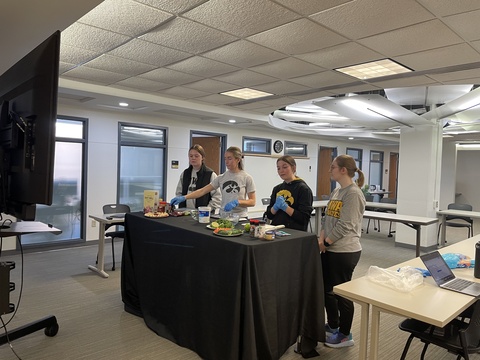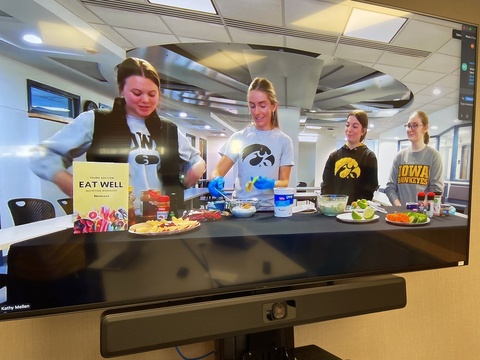By Kaylee Alivo
Throughout the month of March, students in the Community Wellness Guided Practicum in the Department of Health and Human Physiology collaborated with the University of Iowa’s liveWELL program to host virtual food demonstrations in celebration of National Nutrition Month.
Each group of students presented a simple, nutritious recipe that aligned with the theme, “Food Connects Us,” reaching UI faculty and staff through engaging, interactive webinars.
The weekly demonstrations covered a range of topics—from healthy eating at all stages of life to connecting with a nutrition expert. Students rehearsed their presentations in class, incorporated feedback, and worked closely with Kathy Mellen, professor of instruction in the department and, Madison Coyne, a Registered Dietitian and health coach with liveWELL, to ensure their sessions were informative and accessible.

“The goal was to educate University of Iowa employees on nutrition and healthy eating habits, while giving HHP students an opportunity to develop their skills in culinary nutrition, behavior change, and nutrition communication,” Mellen said. For many students, the project became more than just an assignment—it was a hands-on opportunity to grow professionally and connect with others through food.”
Students also recognized the impact their work could have on making nutrition feel more approachable for the campus community.
“Nutrition is something that everyone wants to know about, but a lot [of people] don’t know where to start. These recipes and demos are a great resource for them,” Jillian Plieth, a fourth-year exercise science student in the course said.
Students say this experience also helped them develop vital professional skills.
“I learned the importance of collaboration with group members by sharing responsibilities and combining each other’s strengths to improve our presentation,” Lexi Marler, a third-year health studies student in the practicum said.
Student presenters also received real-time feedback from participants, which helped them gauge the effectiveness of their sessions.
“During the live demo, when we were actually getting answers to our questions, it felt like people were genuinely engaged and interested in our topic,” Plieth added.
The sense of accomplishment also stood out for the students.
“I was proud of how our group was able to work together and problem-solve after our initial food demo rehearsal. It felt great to successfully complete our demonstration and connect with the UI community,” Abby Brodeski, a fourth-year health studies student in the course said.

Addison Merriam, fourth-year health studies student said, “This experience helped me continue to use health, wellness, and nutrition information to promote healthy behaviors to others. I learned specific strategies to engage others and better my presentation skills, which will help me in a variety of ways for my future career.”
Mellen says, the sessions drew between 40 to 60 attendees each, and participants were actively involved through Zoom chats and polls. The liveWELL team also saw meaningful impact from the collaboration. Coyne noted that the sessions were well received, with 67% of attendees saying they were very likely to apply what they learned and 88% feeling confident about recreating the recipes at home.
“Many people want to eat healthier but feel overwhelmed by complicated recipes. These demos helped break that barrier,” Coyne said.
Looking ahead, there are hopes to continue offering similar programs in future semesters.
“Students really enjoyed the opportunity to learn more about faculty and staff and provide food demonstrations,” Mellen added. With the opening of the Food and Nutrition Science lab in the new Health Sciences Academic Building in fall 2026, hands-on learning opportunities like this one are expected to grow—offering even more chances for students to explore how food connects us all.